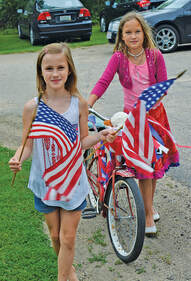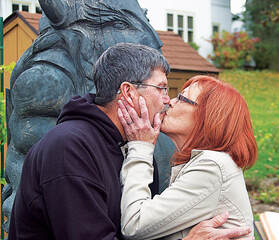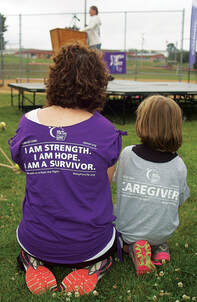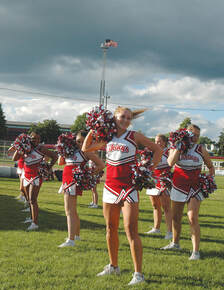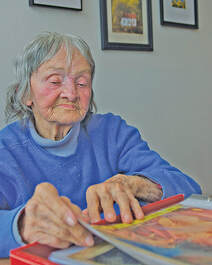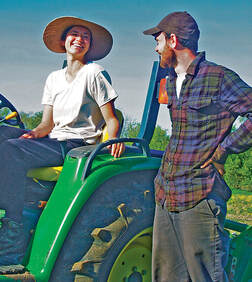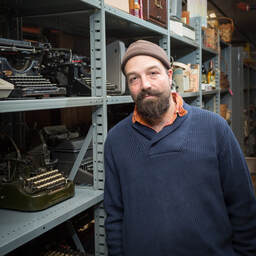A PHOTO ESSAY OF VILLAGE LIFE BY MATT GEIGER
AUTHOR, JOURNALIST AND EDITOR OF THE MOUNT HOREB MAIL
1. "I took this photo on the 240th anniversary of the Declaration of Independence. It shows Phoebe DeWitt and Anna Hofmann heading to the 4th of July Kiddie Parade in Mount Vernon. There is just something about the image that sums up what kids are like in the American Midwest; a unique mixture of friendliness and independence on their faces and in their bearings. These kids just seemed so comfortable in this place and time, and in themselves. It’s something you see fairly often around here, and pretty infrequently in many other places in the country."
2. "Every place is merely a setting. A “stage,” as Shakespeare famously put it. These places are not inherently special; rather, they are special because of the things that happen in them. What better thing can you say about a place, in this case Mount Horeb, than that two people fell in love here? When I was asked to attend a wedding where they celebrated that love, in a community where they don’t live, I knew I would have a chance to capture something special."
3. "I took this photo of students riding in the Mount Horeb High School homecoming parade on a sunny afternoon. It probably looks slightly banal to someone who grew up here, but to me, having grown up just north of Boston on the East Coast, the image has a beautiful shimmer of strangeness (I’m borrowing that phrase from Karl Ove Knausgaard. It’s not something I would have seen growing up; kids riding in the back of a pickup truck, wedged between two flags, both wearing John Deere shirts. They were Midwestern royalty without a hint of that toxic irony that so pervades much of the world."
2. "Every place is merely a setting. A “stage,” as Shakespeare famously put it. These places are not inherently special; rather, they are special because of the things that happen in them. What better thing can you say about a place, in this case Mount Horeb, than that two people fell in love here? When I was asked to attend a wedding where they celebrated that love, in a community where they don’t live, I knew I would have a chance to capture something special."
3. "I took this photo of students riding in the Mount Horeb High School homecoming parade on a sunny afternoon. It probably looks slightly banal to someone who grew up here, but to me, having grown up just north of Boston on the East Coast, the image has a beautiful shimmer of strangeness (I’m borrowing that phrase from Karl Ove Knausgaard. It’s not something I would have seen growing up; kids riding in the back of a pickup truck, wedged between two flags, both wearing John Deere shirts. They were Midwestern royalty without a hint of that toxic irony that so pervades much of the world."
4. "There is a something called the “infinite monkey theorem.” Essentially, it points out that a monkey (even a dim one) that sits at a keyboard and randomly hits keys for eternity will eventually write the works of William Shakespeare. I’m not a very good photographer, but this elegant image I captured at the Mount Horeb art fair in 2016 shows that if you take enough photos, you’ll eventually get a really good one. It’s as if the dancers are defying the laws of physics in unison."
5. "These two cyclists were on a ride when they decided to stop for lunch in Mount Horeb. They were on a long trek, and they were so legitimately happy when they stopped to eat some cheese and crackers in the sun. I have probably encountered thousands of frowning people since this day, seven years ago, but most of their faces have faded from my memory. Yet smiles like these will always stay fresh in my mind. Part of the reason we used this photo in the newspaper was that they clearly found the village to be welcoming, and the backdrop is a sign that says “welcome” in Norwegian. Often, people from elsewhere are best at judging the place you call home, because they see it with fresh eyes."
5. "These two cyclists were on a ride when they decided to stop for lunch in Mount Horeb. They were on a long trek, and they were so legitimately happy when they stopped to eat some cheese and crackers in the sun. I have probably encountered thousands of frowning people since this day, seven years ago, but most of their faces have faded from my memory. Yet smiles like these will always stay fresh in my mind. Part of the reason we used this photo in the newspaper was that they clearly found the village to be welcoming, and the backdrop is a sign that says “welcome” in Norwegian. Often, people from elsewhere are best at judging the place you call home, because they see it with fresh eyes."
|
6. "Back in 2014, people across the globe dumped icy water on themselves to raise money and awareness in the fight against Amyotrophic Lateral Sclerosis (ALS, also known as Lou Gehrig’s disease). Dr. Amanda Hatch and her team took the “Ice Bucket Challenge” to the next level when called in this front loader. Luckily, they also called me, and I got to take a picture of the deluge."
|
7. "I was at the Mount Horeb Sons of Norway Lodge’s 41st annual Kaffe Stue – a big Nordic meal – in 2013 when I happened upon this incredibly authentic smile on
the face of Marlyn Grinde as she greeted her friend, Delma Baker. As usual, the best photos happen when no one notices the camera."
8. "This is the Venerable Lhundup Chowng, strolling the grounds of Deer Park Buddhist Center in Oregon in 2017. Geshe Lhundup Sope, the center’s founder, had died in 2014 after “a life of virtuous deeds” and the monks there were hoping to build a proper place in which to house his cremated remains. Jeff Scott, a Mount Horeb craftsman, overheard them discussing the project at a hardware store and offered to help. I didn’t write anything particularly original here. The whole piece was just kind of a slow burn of kindness and humility due entirely to the people involved. The story told itself. But I did like the fact that I was able to begin an article in the local newspaper with this passage: “Death. Even the most enlightened among us cannot escape its grasp. And in that undeniable impermanence, members of the Buddhist community find dynamic meaning in our short lives. In the inevitability of oblivion, they find delight in the big and small moments that fill our days and nights.” I’ll never understand why popular media in our country so completely ignores philosophy and theology, which I think are essential tools for unlocking our inner selves and the outer world. So I’m always happy when we get to ruminate on these things in the local newspaper. There is nothing like a good mystery."
9. "These first and second grade students were dressed up in farming attire for school one day, and I was there to take a picture. I will never know what provoked this young boy, but I love the passion in his face, combined with the way the young girl is holding him back. He was so small, but there was a certain power in his frame that belied his stature. He was like a time traveler from the 1920s, or something. Like a big guy who just hadn’t grown into his overalls yet."
the face of Marlyn Grinde as she greeted her friend, Delma Baker. As usual, the best photos happen when no one notices the camera."
8. "This is the Venerable Lhundup Chowng, strolling the grounds of Deer Park Buddhist Center in Oregon in 2017. Geshe Lhundup Sope, the center’s founder, had died in 2014 after “a life of virtuous deeds” and the monks there were hoping to build a proper place in which to house his cremated remains. Jeff Scott, a Mount Horeb craftsman, overheard them discussing the project at a hardware store and offered to help. I didn’t write anything particularly original here. The whole piece was just kind of a slow burn of kindness and humility due entirely to the people involved. The story told itself. But I did like the fact that I was able to begin an article in the local newspaper with this passage: “Death. Even the most enlightened among us cannot escape its grasp. And in that undeniable impermanence, members of the Buddhist community find dynamic meaning in our short lives. In the inevitability of oblivion, they find delight in the big and small moments that fill our days and nights.” I’ll never understand why popular media in our country so completely ignores philosophy and theology, which I think are essential tools for unlocking our inner selves and the outer world. So I’m always happy when we get to ruminate on these things in the local newspaper. There is nothing like a good mystery."
9. "These first and second grade students were dressed up in farming attire for school one day, and I was there to take a picture. I will never know what provoked this young boy, but I love the passion in his face, combined with the way the young girl is holding him back. He was so small, but there was a certain power in his frame that belied his stature. He was like a time traveler from the 1920s, or something. Like a big guy who just hadn’t grown into his overalls yet."
10. "I love boxing. It’s one of the most honest things a human being can do. (In fact, some of the first writing I ever did when I moved to Wisconsin was covering mixed martial arts in Madison for coreweekly magazine.) So when I was able to cover the White Collar Boxing Tournament at the Red Mouse in Pine Bluff, I jumped at the chance. Basically, a bunch of people from all walks of life spent months working with professional trainers. It culminated when they stepped into the ring that night. It was brutal,but really inspiring. Nothing brings out the best in people like high stakes, and someone trying to punch you in the face is the very essence of that. What I love about this
image is that the most beautiful thing in the picture isn’t the victor; it’s actually the person who got knocked down. It’s a reminder that defeat, especially honorable defeat, is not necessarily ugly. In fact, sometimes it’s the most beautiful thing in the world."
11. "Okay, full disclosure: this is some of the worst music I have ever heard. It’s a cover band playing their versions of songs that I found vile to begin with. Hair pop/metal
is just the worst. It happens at the Summer Frolic and at various festivals around the Midwest. But while I can’t stand the hair bands of the 1980s, I had to admit that hundreds and hundreds of people – pretty much everyone but me – was having a great time listening to it. Perhaps it’s important to realize that we don’t all have
to like the same things. And sometime you can be happy for other people, merely because they are happy."
12. "We’ve kept chickens in our backyard for many years, so I decided, somewhat on a whim, to publish a series of photos showing people with their hens in Mount Horeb.
I still can’t believe how popular it was. I think we ended up printing a couple dozen of them. It’s probably the most popular thing I’ve ever done in all my years working for newspapers. Josh Arrigoni, who is a really nice guy, somehow managed to look tough and cool while holding one of his chickens, which is no small task, so this image was my favorite of the bunch."
image is that the most beautiful thing in the picture isn’t the victor; it’s actually the person who got knocked down. It’s a reminder that defeat, especially honorable defeat, is not necessarily ugly. In fact, sometimes it’s the most beautiful thing in the world."
11. "Okay, full disclosure: this is some of the worst music I have ever heard. It’s a cover band playing their versions of songs that I found vile to begin with. Hair pop/metal
is just the worst. It happens at the Summer Frolic and at various festivals around the Midwest. But while I can’t stand the hair bands of the 1980s, I had to admit that hundreds and hundreds of people – pretty much everyone but me – was having a great time listening to it. Perhaps it’s important to realize that we don’t all have
to like the same things. And sometime you can be happy for other people, merely because they are happy."
12. "We’ve kept chickens in our backyard for many years, so I decided, somewhat on a whim, to publish a series of photos showing people with their hens in Mount Horeb.
I still can’t believe how popular it was. I think we ended up printing a couple dozen of them. It’s probably the most popular thing I’ve ever done in all my years working for newspapers. Josh Arrigoni, who is a really nice guy, somehow managed to look tough and cool while holding one of his chickens, which is no small task, so this image was my favorite of the bunch."
|
13. "This picture of Kristin Bush, taken during a volleyball game at the Mount Horeb Summer Frolic in 2013, was taken shortly after I took over as editor of the Mount Horeb Mail. I put it on the front page because it illustrates the fact that we can still laugh, even when we fall down, in this case in a considerable patch of mud."
|
14. "In 2016, a group of Ho Chunk dancers visited Grundahl Park in Mount Horeb as part of an event organized by the Driftless Historium. The hardest part of selecting photos for this show was whittling it down to include only one picture from that day. The movement and the physical storytelling were thrilling to watch. The performers spoke about culture, history and art, and they explained the complexities of living in two different worlds. They put on traditional regalia, playing drums, singing and dancing. Then they had the audience join in. Then they ate pizza and relaxed for a bit. Two worlds, indeed."
15. "One winter day, I headed to the ice rink in downtown Mount Horeb, which is just a modest low area with water sprayed on it once the weather gets cold, to get a photo. What I found was yet another reminder that people, who are so resilient, can find joy in unexpected places. Those who can only smile when they are
on top of the world are doomed. But anyone who can laugh like this when they crash onto the ice is destined for a good life."
16. "This was not a posed photo. It was just one of those moments that seemed to symbolize a universal narrative. It was the 2014 Relay for Life, and it perfectly showcased the interconnected nature of our lives as we face down the many tragedies of all our lives. Everyone is something, both to themselves and to those around them. I particularly love the way this image shows how our roles can be reversed in life, and the smallest among us will one day – perhaps soon, perhaps many years from now– be caretakers of us all; of our civilization, and of our entire planet."
17. "My favorite sports used to be baseball, basketball and boxing. That was before I moved to Wisconsin and began celebrating Scandihoovian each winter. Now, my favorite sport, obviously, is turkey bowling. Pictured here, contestants line up to give it a shot in 2018."
on top of the world are doomed. But anyone who can laugh like this when they crash onto the ice is destined for a good life."
16. "This was not a posed photo. It was just one of those moments that seemed to symbolize a universal narrative. It was the 2014 Relay for Life, and it perfectly showcased the interconnected nature of our lives as we face down the many tragedies of all our lives. Everyone is something, both to themselves and to those around them. I particularly love the way this image shows how our roles can be reversed in life, and the smallest among us will one day – perhaps soon, perhaps many years from now– be caretakers of us all; of our civilization, and of our entire planet."
17. "My favorite sports used to be baseball, basketball and boxing. That was before I moved to Wisconsin and began celebrating Scandihoovian each winter. Now, my favorite sport, obviously, is turkey bowling. Pictured here, contestants line up to give it a shot in 2018."
18. "Good photos tell good stories. This image is packed with meaning. As usual, capturing it was pure luck. It was 2013, and the people of Mount Horeb were holding the Relay For Life at Grundahl Park. When a group of local cheerleaders performed, ominous storm clouds rolled in behind them. Yet they continue to smile, continued to cheer, perhaps even more than before. The juxtaposition of these young women, so full of life and spirit, against the backdrop of a dark storm, it something I will never forget. It’s such an apt representation of what people do when they are faced with cancer, and storms of many other kinds."
19. "In 2013, someone gave me a news tip. They said there was a “little old lady” in Blue Mounds who used to be a famous model. I found her, and we ate breakfast together while she showed me hundreds of old magazine photos and newspaper clippings, many of which showed her topless a half century earlier. Her name was Bonnie
Bakken. (Well, she went by many names over the years, actually.) She adored the story we published about her. In addition to the thousands of print copies that went out,
it also was one of the most popular stories I’ve ever posted online. Bonnie and I (with enormous help from producer Erika Janik) later recorded some of her stories for a Wisconsin Life segment on Wisconsin Public Radio. After that, Bonnie was kind enough to let us print an image of her on the cover of a book I wrote, in which she was featured in a story. While she became famous when she was young, and primarily for her face and some other body parts, in this picture it is her hands that stand out. They are so textured with age and arthritis, gingerly turning the pages of her life, going backward and forward in time. I am writing this three days after her death. I feel very
lucky that Bonnie and I got to tell these stories – her stories – together."
20. "George Washington once said he would rather be home on his farm than be emperor of the world. When I took this picture of farmers Sarah Leong and Patrick Hager
back in 2014, I got the impression they felt the same way."
19. "In 2013, someone gave me a news tip. They said there was a “little old lady” in Blue Mounds who used to be a famous model. I found her, and we ate breakfast together while she showed me hundreds of old magazine photos and newspaper clippings, many of which showed her topless a half century earlier. Her name was Bonnie
Bakken. (Well, she went by many names over the years, actually.) She adored the story we published about her. In addition to the thousands of print copies that went out,
it also was one of the most popular stories I’ve ever posted online. Bonnie and I (with enormous help from producer Erika Janik) later recorded some of her stories for a Wisconsin Life segment on Wisconsin Public Radio. After that, Bonnie was kind enough to let us print an image of her on the cover of a book I wrote, in which she was featured in a story. While she became famous when she was young, and primarily for her face and some other body parts, in this picture it is her hands that stand out. They are so textured with age and arthritis, gingerly turning the pages of her life, going backward and forward in time. I am writing this three days after her death. I feel very
lucky that Bonnie and I got to tell these stories – her stories – together."
20. "George Washington once said he would rather be home on his farm than be emperor of the world. When I took this picture of farmers Sarah Leong and Patrick Hager
back in 2014, I got the impression they felt the same way."
|
21. "This is the most recent photo in the show. It’s also one of the most inspiring stories. In the spring of 2020, farmer John Kahl planted corn and soybeans. Farming is, as an old saying goes, the profession of an optimist. John died shortly thereafter, leaving his final crop growing in the fields. Contrary to what we see on the news and on late night talk shows, people are generally good, kind, and generous, especially in Wisconsin. So of course, John’s friends, neighbors and family came together in the fall to harvest the fruits of his labor. They all downplayed it as just a normal thing that he would have done for any of them. But it was clearly special, and it was much-needed proof that hatred, while it certainly generates clicks, is
not the entirety of the human story." |
22. "In 2016, 49 innocent people were murdered at a gay nightclub in Florida. Here in Mount Horeb, at Grandma Foster Park, citizens gathered to read their names, mourning the life that was robbed from them but also celebrating the humanity that even death could not obliterate. It was an emotional gathering, for obvious reasons, and when words of comfort were not enough, people offered a warm embrace to help make it through the day."
|
23. "In 2014, I wrote a story about a professional Tug-Of-War team based out of Mount Vernon. I expected it to be a goofy excuse to drink beer and hang out. Instead, I found out they are global competitors; serious athletes who cultivate extraordinary strength, stamina and hand callouses throughout the year. Life absolutely brims with these kids of unexpected stories if you keep your eyes open."
|
|
24. "It’s hard to describe the magic of Little Norway to someone who has not been there. Basically, it was like walking into the Shire in The Hobbit. A deep valley though which ran a shimmering stream. Grass-roofed log homes. The rustling of tall trees. It was incredible. Each summer, they used to celebrate Midsummer’s Eve, just as people have for thousands of years. It’s always a bittersweet party, because it marks the point at which the sun will begin its slow retreat as winter encroaches yet again. At the last Midsummer’s Eve Party, as Little Norway was closing, it was particularly poignant. This image shows owner Scott Winner in the middle of a family embrace, with a blazing pyre behind him. The look in his eyes says so much about how people and places are linked."
|
|
0.026 seconds. BY MATT GEIGER
That’s the total length of time captured in all of the photographs in this exhibit. The fact that so much meaning, so many aspects of human life, can be packed into the space of about a quarter of a second should make us all feel nearly immortal. I have never been a particularly good photographer. I never wanted to be one, actually. I did always want to be a writer, and taking pictures is part of the deal when you write for newspapers and magazines. So, somewhat reluctantly, I have taken something like 100,000 photos during my time working as a community journalist. Which is probably good because, as Henri Cartier-Bresson, the famous French humanist photographer pointed out, “your first 10,000 photographs are your worst.” Because I don’t have a great eye for composition, or light, (or any of the things that make a great photograph, really), I always focus on narrative elements. I look for pictures that tell stories. Simply put, these 26 images, taken in and around a small village in the American Midwest, tell some of my favorite stories. Someone once told me that being a reporter is like receiving a backstage pass to life, and we all know that the best tales, the ones that make your jaw drop or make you cry or warm your heart, take place backstage. The stage is just a façade. A couple years ago, I stopped using my expensive work camera to take photos. It was too conspicuous. It was always noticed, and noticing it changed the way people behaved. Their faces would tighten and they would become too self-aware, too focused on the camera and not on the moment. I felt like I was taking the same photo again and again: a picture of various people noticing a camera. That’s why I only take pictures with my phone these days; because it allows me to be less visible. Whether taken with a nice Nikon or my cracked Samsung, nearly all of these images were snapped when I was relatively invisible, so hopefully I did not interfere with these stories too much. Life - even a short life - contains so many of these little moments that they might as well be infinite. Each one, as you can see when you look at the people in these photos, has the potential to contain immense, stunning meaning. I worry frequently about the state of the world. About our warring tribes and constant “othering” that has spread faster than any disease and seems to have embedded itself in every ideological camp. I truly wonder what the future will be like. But when I see these faces, the movement and meaning in all these miniscule slivers of time, I am filled with hope for the future. Because every person on the planet – all 8 billion of us – has been gifted with an embarrassment of riches: we have been given little, tiny moments that can feel infinitely meaningful. |
ARTIST BIO
|
Matt Geiger was born in Maine and raised on a farm in Massachusetts, but he has deep roots in Wisconsin. Both of his parents are from the state, and his great grandparents farmed land just outside Mount Horeb. He studied philosophy and religion at Flagler College in Saint Augustine, Florida, where he began working in journalism, as well as writing about that city’s founding (which took place nearly half a century ago) for the Mission of Nombre De Dios and Nuestra Señora de La Leche y Buen Parto. He moved to Wisconsin nearly 20 years ago and has resided in Mount Horeb for more than a decade. He is the author of numerous magazine, radio and newspaper articles and stories, as well as two books. His work has won 11 Wisconsin Newspaper Association awards and a Midwest book award.
Geiger has worked for News Publishing Co. for 16 years, serving as the Mount Horeb Mail’s editor since 2013. He is also the executive editor for the Star News, the Times-Tribune, the Home News, the Independent and the Post Messenger Recorder. |
For more information about "0.026 Seconds: The Magnitude of Small Moments,"
visit the Upcoming Events page here: http://www.mthorebhistory.org/upcoming-events.html
visit the Upcoming Events page here: http://www.mthorebhistory.org/upcoming-events.html

